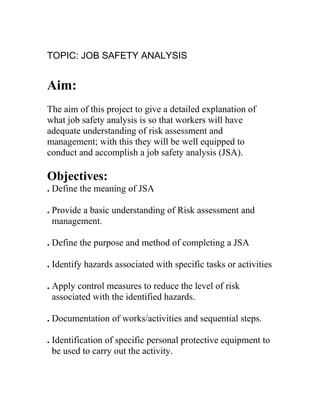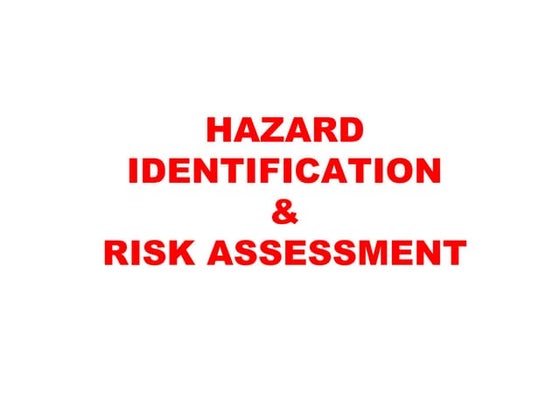JOB SAFETY ANALYSIS
- 1. TOPIC: JOB SAFETY ANALYSIS Aim: The aim of this project to give a detailed explanation of what job safety analysis is so that workers will have adequate understanding of risk assessment and management; with this they will be well equipped to conduct and accomplish a job safety analysis (JSA). Objectives: . Define the meaning of JSA . Provide a basic understanding of Risk assessment and management. . Define the purpose and method of completing a JSA . Identify hazards associated with specific tasks or activities . Apply control measures to reduce the level of risk associated with the identified hazards. . Documentation of works/activities and sequential steps. . Identification of specific personal protective equipment to be used to carry out the activity.
- 2. DEFINITION: Job safety analysis is a method of identifying hazards and developing ways to eliminate, control or manage them. Job safety analysis is a management tool which is used to help us work safely without incurring accidents. It entails reasoning and thinking used in hazard identification and elimination. It involves breaking jobs down into sequence or stages, identifying the hazards or risks associated with each sequence or stage and instituting measures aimed at eliminating ,minimizing or reducing the hazards so that tasks can be accomplished without injury to personnel, damage to equipments and environmental pollution. JSA increases awareness in work place which helps in preventing injury and illnesses. Avoid Making the breakdown so detailed that an unnecessarily large number of steps results or making the job breakdown so general that basic steps are not recorded. Methods of doing JSA
- 3. . By direct observation . By group discussion . By recall and check 1. Direct observation ââObservation promotes learningââ People are more likely to learn new things about a job when they observe the job for a JSA than when they rely on memory. Memory can only tell you what you already know while observation opens the ways of noticing things you have never noticed before. A limitation of the observation method is that it cannot be readily applied to jobs done infrequently. 2. Group discussion In this method, JSA is accomplished by a group of people familiar with the job. Under the guidance of the supervisor the group members use their collective experience to identify the job steps and the potential accidents in each and develop good solutions. The participants in the discussion should be those with most knowledge about the job. In either case, the supervisor needs to be competent in group discussion techniques. He should be able to stimulate a group to obtain the maximum contribution from each of its members and guide the discussion down to the most productive paths.
- 4. It is used in pre-planning the safe execution of larger jobs. Documentation of the results of the group discussion is also very important. 3. Recall and check In this method recall and check is used by individual supervisors who prepare preliminary version of the JSA instead of direct observation of the job. He then checks the preliminary version by discussing it with others. An already prepared checklist is used in this method. What jobs require JSA? All jobs irrespective of how familiar we are with their procedures require JSA nevertheless there are some jobs that much premium are placed on regarding JSA application. . Hazard potential Some jobs have no history of lost time injury (LTI) yet they have considerable potential for crippling injury or death. They are obviously good candidates for JSA. . History of accidents Job with a history of many accidents are also good candidates for JSA. . Newly established jobs Changes in tools, equipment and machinery or production methods create new jobs from time to time. A JSA of a new job establishes the hazards and safe procedures before anyone has accident. It also provides an excellent basis for training of workers in how to handle the new job safely.
- 5. . Jobs with high injury occurrence Those jobs that produced serious injuries are also good candidates for JSA. They should be given priority over jobs that have produced only minor injuries as they have proven their potential to hurt people steadily. . Jobs that involve simultaneous operation Simultaneous operations such as welding and painting need JSA. Jobs that involve emission of radioactive substances . Jobs done in confined spaces . Jobs that entail handling of heavy leads . Jobs that produce high velocity particles . Hot works . Jobs done in noisy areas. . Jobs done in noisy areas. Key points for identifying hazards/Potential accident. These questions should be born in mind when doing the JSA . Can the employee be struck by any moving object while
- 6. doing his job step? . Can the employee strike against or make injurious contact with anything? . Can he be caught in, on, or between anything? . Can he be caught on protruding objects? . Can he be caught in confined spaces? . Can he fall on the same level? . Can he fall to a different level? . Can he strain or overexert? . Can the employer slip, trip on anything? . Can he be exposed to injurious conditions such as cold, heat, fumes, pressure, chemicals, asbestos, etc . Can the employer injure a fellow worker? . Can damage of equipment occur? . Can pollution occur? Methods of hazard/risk control or management according to hierarchy These are safeguard measures put in place to eliminate or reduce the consequences of the identified risks or hazards. 1. By elimination 2. By substitution 3. By Isolation 4. By engineering control achieved through designing automatic or digital tools and equipment
- 7. 5. By administrative control such as education, safety training etc 6. By personal protective equipment (PPE) Important approaches to achieving workable JSA 1. The ââwhat Ifââ approach. The purpose of a what-if analysis is to consider the potential impact of unexpected events that could produce adverse consequence. This approach involves asking important questions which when answered opens a floodgate of solutions aimed at hazard identification, management and control. What can go wrong? What if anything goes wrong? It is from these questions that so many hazards are identified and safety measures put in place to reduce, manage or eliminate them. ââWhat if the boat sinksââ that is why life rafts are provided. ââWhat if there is fire outbreakââ that is why fire extinguishers are provided. ââWhat if I have flat tyre on the wayââ that is why a spare tyre is provided.
- 8. ââ What if there is product/pressure on the line when we are opening the flangeââ that is why the line must be depressurized before we open the flange. ââ What if the sling wire used in lifting a load with a crane breaksââ that is why all slings must be tested and found ok before use and correct sling must be used in accordance with the tonnage of the load being lifted. And no personnel should stand under a suspended load. After you have developed a JSA, ask yourself â¦.What is the worst thing that could possibly happen? Then look back through the JSA. Ask yourselfâ¦. Have I eliminated the hazards that could allow the worst thing to happen? If noâ¦.Revise the JSA so that you do eliminate those hazards. 2. Step back 5 x 5 This is a process that identifies hazards before a task is started. Engages the mind before the hand Step back 5 paces from the job Invest 5 minutes to step through the work in your mind. When to use step back 5 x 5 During toolbox meetings before the commencement of work.
- 9. Throughout the days activities, especially after breaks. Group meetings at the completion of the days work. How is step back 5 by 5 done? Stop and think . Observe . Step through the task in your mind . Think about what else is happening in the area . Identify the hazards . How can I control the hazards? . Is the hazard controlled? During the job, after meals or breaks After the job . Observe the work area . Control hazards that may have been created . Reflect . Did you feel safe? . Were others around you working safely? . How can I improve next time? . Is the hazard controlled? Benefits of JSA include: Increases safety awareness . Allows input from key players . Increases knowledge of the job . Leads to written procedures . Has a future use/benefits (similar, identical jobs) . Accident prevention responsibilities addressed . Provides training materials . Saves time â correct equipment identified and available . Improves communication . Educate workforce in the use of JSA procedure.
- 10. Reduces accidents. Job safety analysis worksheet. WORK GROUP: EQUIPME LOCATIO DATE: JOB STAR DETAILED JOB DESCRIPTION : PREPARED BY: REVIEWE NAME: NAME: SIGN: SIGN: MANDATORY PPE: Safety Boots, Coverall, Hard Hats and Safety Glasses ADDITIONAL PPE REQUIRED: TOOLS REQUIRED: SEQUENCE OF BASIC JOB STEPS P JSA DISCUSSION AT TOOL BOX MEETING, LED BY: NAME: JSA TEAM MEMBERS: NAMES: SIGN

























































